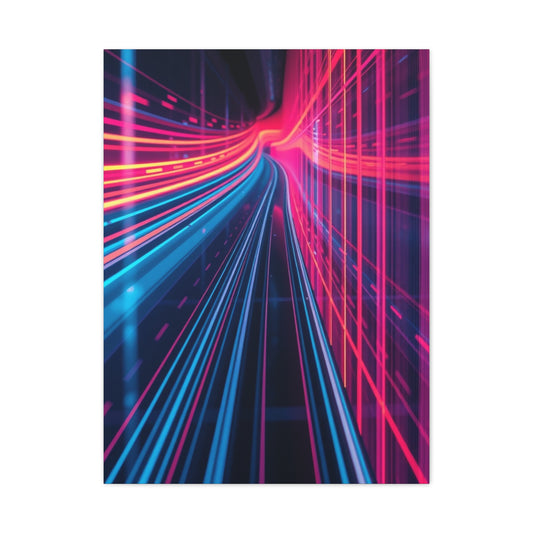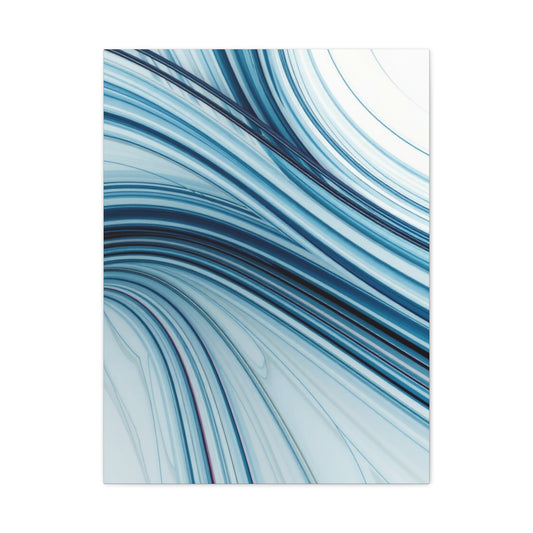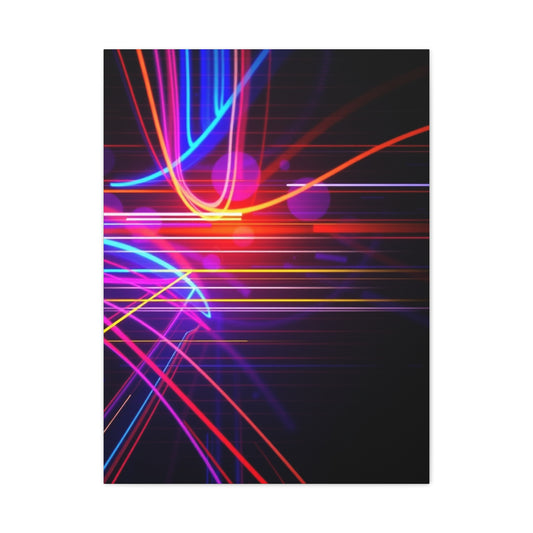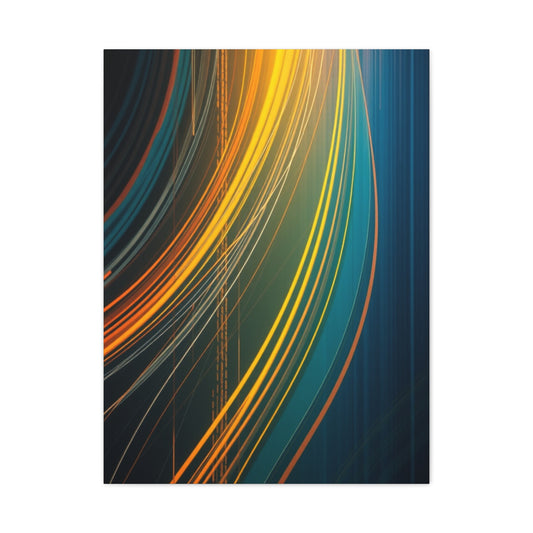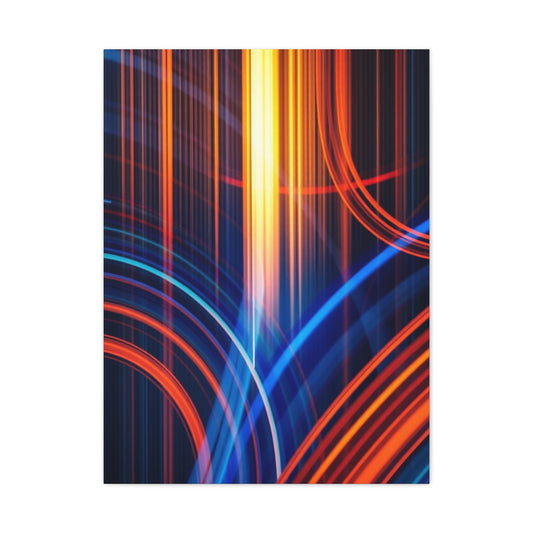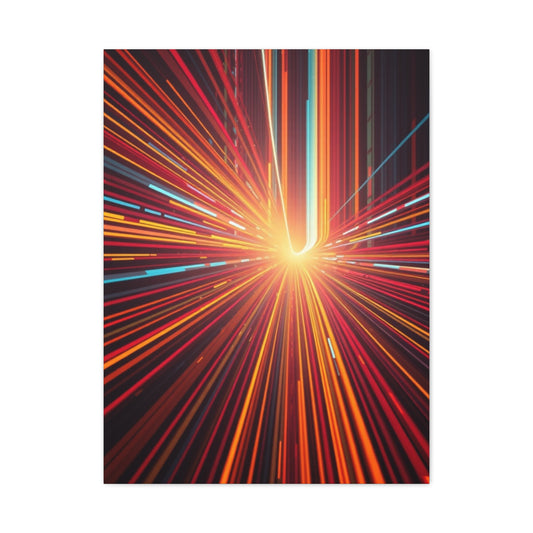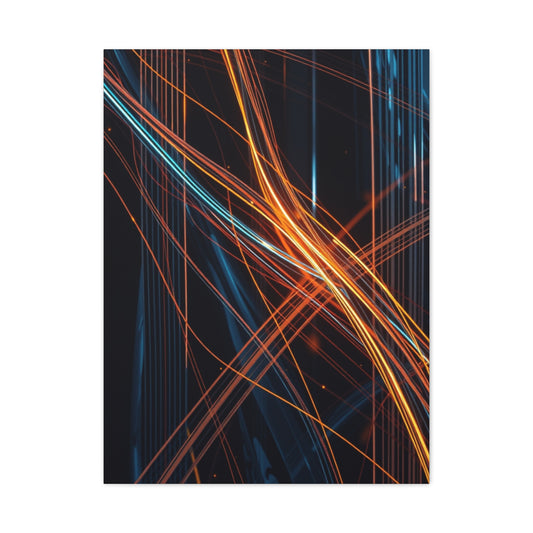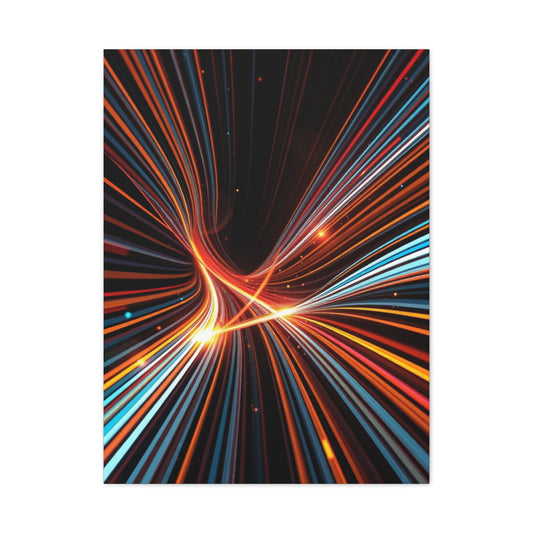The Art of Linear Abstraction: Wall Art Ideas for Stylish Interiors
Welcome to the world of abstract art, a realm where color, form, texture, and imagination converge to create experiences that are as personal as they are universal. Decorating with abstract art can feel like stepping into an unfamiliar territory at first. Unlike landscapes or portraits, these works do not recognizably replicate reality. Instead, they open a door into a visual language of emotions, moods, and sensations. This very freedom is what makes abstract art such a compelling choice for the home. It invites interpretation, sparks curiosity, and creates conversations that last long after the first glance.
Bringing abstract art into your space is not about following strict design rules but about exploring possibilities. A bold impasto painting with sculptural layers can breathe drama into a living room, while minimalist black and white abstract art lends sophistication to a modern office. A pastel-toned geometric canvas can bring harmony to a bedroom, just as a large, colorful abstract print can inject joy and energy into a family room. The diversity is endless, yet each piece shares a unifying power: the ability to transform blank walls into reflections of personality and style.
This guide unravels the mystery of abstract art, tracing its evolution, explaining its essence, categorizing its forms, and presenting ways you can seamlessly integrate it into your home. Whether you are a beginner who wants to buy your first canvas print or a seasoned collector expanding a gallery wall, you will find practical insights and inspiring ideas that bridge the worlds of art appreciation and interior design.
Historical Background
To understand abstract art’s impact on home décor, one must first look back at its origins. Abstract art emerged in the late nineteenth and early twentieth centuries as a radical break from realism. Artists began questioning the long-standing tradition of painting what the eye sees and instead explored the inner landscapes of thought and feeling.
Pioneers such as Wassily Kandinsky, often called the father of abstract art, believed that color and form had a spiritual resonance. He created works that vibrated with energy, designed not to depict objects but to stir emotions. Around the same time, artists like Piet Mondrian pursued harmony through strict geometric patterns, distilling reality into lines, shapes, and balanced colors. Meanwhile, Kazimir Malevich’s Suprematism introduced stark simplicity, using basic shapes to represent pure artistic feeling.
The mid-twentieth century witnessed the explosive rise of abstract expressionism in America, with figures like Jackson Pollock and Mark Rothko redefining what painting could be. Pollock’s drip paintings celebrated chaos and motion, while Rothko’s vast color fields invited meditative reflection. These movements were not confined to galleries; they began influencing architecture, design, and even the way people thought about personal spaces.
As abstract art matured, it splintered into sub-styles ranging from minimalist line art to bold geometric compositions, fluid acrylic pours, and mixed-media collages. Today, abstract art is celebrated not only as a high-art form but also as an accessible medium for everyday interiors. From prints on fine art paper to oversized canvases and luminous metal panels, it has entered homes across the world, reflecting both individual taste and global artistic legacies.
Core Concepts and Foundations
At its heart, abstract art is built on a few core principles that guide its creation and interpretation. These principles help explain why a seemingly simple arrangement of shapes or colors can resonate so deeply.
One foundation is the primacy of emotion. Unlike representational art, which tells a visual story, abstract art conveys a mood. A sweeping brushstroke in fiery red can suggest passion or conflict, while a field of soft blues evokes calm. This makes abstract art adaptable to different environments: a serene abstract piece may fit a tranquil bedroom, while an energetic one can enliven a bustling family space.
Another concept is the language of form and line. Geometric abstraction thrives on clean, measured shapes that communicate stability and balance. Organic abstraction, in contrast, emphasizes flowing, irregular contours that feel natural and spontaneous. Together, these elements create a spectrum of possibilities ranging from highly structured to entirely freeform.
Texture is equally crucial. Some works rely on flat, smooth applications of color, perfect for sleek, modern interiors. Others use thick, layered impasto techniques that introduce a tactile, almost sculptural quality to the wall. Texture alters not only how the piece looks but also how it interacts with light and space.
Finally, there is the principle of interpretation. Abstract art does not impose meaning but invites the viewer to complete the dialogue. Two people may stand before the same painting and see entirely different stories. This subjectivity is what makes abstract art personal and why it thrives in private homes—it adapts to the sensibilities of the individual.
Types and Categories
The world of abstract art is vast, encompassing diverse types and categories that cater to different aesthetics and atmospheres. Understanding these variations allows you to choose pieces that complement your personal taste and living environment.
One prominent type is geometric abstraction, characterized by clean lines, symmetry, and mathematical balance. Pieces like mid-century modern abstract prints or large geometric canvas sets offer order and clarity, making them ideal for offices, dining rooms, or minimalist interiors.
In contrast, abstract expressionism celebrates spontaneity and raw energy. Works in this category often feature bold brushstrokes, splattered paint, and layered textures. A textured impasto canvas or a vibrant expressionist print can become a statement focal point in a living room or an entryway, setting an immediate tone of dynamism.
Minimalist abstract art reduces composition to its essentials, often employing monochromatic palettes or simple line drawings. Black and white abstract wall art, for example, exudes timeless elegance and pairs effortlessly with modern, uncluttered spaces.
Another significant type is fluid and organic abstraction, such as acrylic pour paintings or watercolor-inspired designs. These pieces capture movement and flow, often resembling natural forms like rivers, clouds, or stone strata. They are well-suited for bedrooms or bathrooms where serenity and softness are desired.
Mixed media and contemporary digital abstraction also play a growing role today. Artists combine paint with collage, photography, or digital manipulation to produce layered, innovative works. These contemporary pieces resonate with modern lifestyles and often find a place in eclectic gallery walls or high-tech interiors.
By categorizing abstract art, you can better align it with your home’s architecture and design. A bold geometric panel might complement an industrial loft, while a pastel-toned fluid piece softens a rustic cottage interior. The key is not just to recognize the type but to envision how it breathes into the larger narrative of your space.
Practical Applications
Once you grasp abstract art’s foundations and types, the next step is bringing it into your home in thoughtful ways. Decorating with abstract art is less about following rigid formulas and more about using intuition guided by design principles.
Start with scale. Oversized abstract canvases make a bold statement, anchoring large walls above sofas, beds, or dining tables. They create a singular focal point that defines the room’s personality. Smaller pieces, on the other hand, excel in clustered arrangements, such as gallery walls that mix prints, photographs, and even sculptures, with an abstract canvas acting as the energetic centerpiece.
Color integration is another practical aspect. A piece of abstract art can inspire your entire décor scheme. For instance, a blue and gold abstract painting can inform the choice of cushions, rugs, and accessories, creating cohesion. Conversely, a neutral-toned abstract work with creams and grays can provide grounding for more colorful furnishings around it.
Placement also matters. In living rooms, above-sofa abstract art is a timeless choice. Bedrooms benefit from soothing, horizontal pieces above the headboard, while hallways and staircases offer opportunities for vertical compositions that draw the eye upward. Even functional spaces like kitchens or bathrooms can be elevated with small yet impactful abstract prints.
Texture and material selection shape the overall effect. A canvas painting radiates classic charm, while metal or acrylic prints bring modern sheen and vibrancy. Fine art paper prints framed with museum-quality glass offer refinement for formal areas. Choosing the right material ensures the art not only looks appealing but also fits seamlessly into the environment.
Lastly, consider lighting. Abstract art thrives under thoughtful illumination. Track lighting or wall-mounted fixtures can highlight the nuances of brushstrokes, textures, or metallic sheens, ensuring that the art interacts dynamically with the room throughout the day.
By understanding these practical applications, you empower yourself to transform blank walls into expressive statements. Abstract art becomes more than decoration—it becomes an integral part of your home’s identity, shaping how the space feels and how it reflects your personal story.
Techniques and Methods
Abstract art thrives on diversity of technique, with each method offering its own language of expression. When thinking about incorporating abstract art into home décor, understanding how these works are created can deepen appreciation and help in selecting pieces that resonate.
One of the most celebrated methods is impasto painting, where artists apply paint in thick, textured layers. The raised surface creates dimension and a tactile presence that changes with light and shadow. A textured abstract impasto canvas can become an anchor in a modern living room, radiating depth and energy.
Equally fascinating is fluid art, often achieved with acrylic pour techniques. Colors are poured, tilted, and swirled across the surface, creating organic patterns that echo natural formations like marble, rivers, or celestial skies. These fluid pieces lend an ethereal quality and are particularly striking in bedrooms or serene lounge areas.
Geometric abstraction relies on precise shapes, clean edges, and mathematical balance. Artists may use rulers, masking tape, or digital design tools to achieve symmetry and sharpness. These works translate beautifully into contemporary interiors, especially when reproduced as geometric abstract canvas prints or metal wall art panels.
Minimalist line art is another technique that has surged in popularity. With just a few elegant strokes, an artist can create forms that feel both sophisticated and profound. Black and white minimalist abstracts often adorn office walls, hallways, or modern bedrooms, complementing uncluttered interiors.
Artists also experiment with mixed media, layering paint with collage, textiles, or found objects. This approach produces richly layered compositions that evoke complexity and intrigue. Such works can act as conversation starters in dining rooms or eclectic gallery walls.
Finally, the role of digital methods cannot be ignored. Contemporary abstract art often emerges from tablets and design software, allowing for seamless blending of photography, illustration, and painting. These works, when printed on acrylic or metal, achieve a luminous vibrancy that traditional methods sometimes cannot match.
Understanding these methods not only informs purchasing choices but also provides insight into how each piece might transform a given space. A bold impasto piece may feel commanding, while a delicate watercolor-inspired abstract might create a tranquil, airy environment.
Challenges and Common Mistakes
While abstract art offers tremendous creative freedom, decorating with it comes with certain pitfalls. Recognizing these challenges helps in making thoughtful decisions that enhance rather than overwhelm your living environment.
One of the most common mistakes is choosing art without considering scale. A tiny abstract print hung above a wide sofa can look lost, while an oversized canvas in a narrow hallway may feel suffocating. The key is proportion—art should feel integrated with its surroundings, not disconnected.
Another frequent error is neglecting color harmony. Abstract art often employs striking palettes, but if a piece clashes with existing furnishings, the result may feel chaotic rather than intentional. For example, a neon-hued abstract canvas might jar against a room dominated by muted earth tones. Instead, consider works that either echo dominant shades in your décor or introduce complementary tones that enhance balance.
A related misstep is relying too heavily on matching décor. While it is tempting to pull colors directly from a painting into pillows and rugs, over-coordination can strip the art of its individuality. Abstract art thrives when it maintains a sense of independence within a space, offering contrast rather than mere repetition.
Improper placement is another challenge. Hanging a canvas too high or too low can disrupt the flow of a room. A guiding principle is to keep the center of the artwork at eye level, though exceptions exist for taller spaces or layered gallery walls. Similarly, crowding too many pieces onto a single wall can create visual noise. Sometimes, restraint—a single oversized abstract work—is more powerful than abundance.
Material choice also presents pitfalls. A fine art paper print may lose its impact if framed with low-quality materials, while a high-gloss acrylic may reflect too much light in a sunlit room. Selecting the right medium for the environment ensures longevity and visual harmony.
Finally, there is the challenge of personal connection. Abstract art is highly subjective, and choosing purely based on trend can lead to regret. A piece may be fashionable today, but feel out of sync with your personality tomorrow. The solution is to select works that resonate emotionally, that make you pause, reflect, or smile each time you walk past.
By navigating these challenges thoughtfully, homeowners can avoid common decorating missteps and allow abstract art to shine in its true potential.
Trends and Future Outlook
Abstract art is constantly evolving, adapting to cultural currents, design movements, and technological innovations. Understanding current trends and anticipating future directions can guide collectors and decorators in making choices that feel both timely and enduring.
One dominant trend is the rise of minimalist abstraction. Clean black and white line art, subtle tonal variations, and understated forms resonate with modern design philosophies that favor simplicity. These pieces suit urban apartments, offices, and Scandinavian-inspired interiors where less is more.
Simultaneously, there is a growing fascination with large-scale statement pieces. Oversized abstract canvases or panoramic prints dominate walls, transforming them into immersive experiences. Such works are particularly impactful in open-plan living spaces where scale is essential to avoid emptiness.
Another emerging movement is nature-inspired abstraction. Artists are exploring palettes and forms that echo earth, water, and sky—sandstone textures, oceanic swirls, or forest greens. This trend connects abstract art to biophilic design, aligning interiors with the natural world.
The integration of metallics and iridescence is also gaining traction. Gold, silver, and pearlescent finishes add luminosity and luxury, catching light in dynamic ways. These accents elevate living rooms and entryways, giving them a sophisticated aura.
Technological advancements are shaping abstract art’s future. Digital and generative artworks are increasingly being printed on acrylic or metal, offering unparalleled vibrancy. Some pieces even exist as dynamic digital displays, evolving with algorithms that shift patterns and colors over time. This futuristic form of abstract art redefines what it means to decorate a home, blending art with technology.
Looking ahead, sustainability will play a critical role. Collectors are beginning to seek eco-friendly materials, from recycled canvases to water-based pigments, ensuring that their décor choices align with environmental consciousness.
Abstract art’s adaptability ensures its continued relevance. It evolves alongside architecture, fashion, and technology, always finding fresh ways to speak to human emotion and modern living. Its future lies not only in traditional canvases but in interactive, sustainable, and boundary-pushing forms that redefine the role of wall art in the home.
Expert Insights
To fully appreciate abstract art’s role in decoration, it helps to consider perspectives from curators, interior designers, and artists who work with these pieces daily. Their insights reveal not only aesthetic values but also psychological and practical dimensions.
Interior designers often emphasize that abstract art catalyzes atmosphere. A single canvas can shift a room from austere to inviting or from plain to dramatic. They recommend starting with art as a focal point and building the décor around it rather than treating it as an afterthought. In this way, the artwork sets the tone for furniture, textiles, and lighting choices.
Curators highlight the emotional endurance of abstract art. Unlike representational works, which may lose novelty once the subject becomes familiar, abstraction continues to intrigue. Viewers discover new forms, shapes, and interpretations with each viewing, making it ideal for personal spaces that one inhabits daily.
Artists themselves often stress the importance of viewer participation. Abstract works are intentionally open-ended, leaving space for the observer’s imagination. An artist may approach a canvas with one emotional intent, but once the work is complete, its meaning multiplies in the hands of viewers. This interactive quality makes abstract art uniquely personal for homeowners.
Psychologists who study aesthetics have noted that abstract art can influence mood and mental states. Vibrant compositions may uplift energy levels, while calm neutral palettes promote relaxation. Homeowners can strategically select works not only for visual appeal but also for their ability to shape emotional environments.
Collectors add a pragmatic perspective, reminding enthusiasts to consider investment and longevity. While some works are chosen purely for décor, others hold long-term artistic or monetary value. Prints, while affordable and accessible, differ from original canvases in both uniqueness and potential appreciation.
Together, these insights affirm that abstract art is more than decoration. It is an active, transformative force in the home—shaping how we experience space, how we feel within it, and how we project our identity to others. Its open-ended nature ensures it remains endlessly engaging, a dialogue between artist, art, and observer.
Emerging Trends in Wall Art
Wall art has always evolved with cultural shifts, aesthetic preferences, and technological advancements. What once was a purely decorative element has now become a defining feature in modern interiors. Today’s emerging trends in wall art reflect a desire for personalization, innovation, and a deeper connection between the viewer and their environment.
One of the most notable trends is the embrace of large-scale abstract wall art. Oversized canvases dominate feature walls, transforming entire spaces into immersive visual experiences. Rather than scattering several small pieces across a wall, homeowners are opting for commanding singular works that exude confidence. These monumental artworks create presence and become the gravitational center of the room.
Another powerful direction is biophilic-inspired abstraction, where artists draw from nature’s forms and colors. Works resembling natural landscapes, fluid geological layers, or organic water-inspired movements bring harmony into homes. These pieces align with the increasing focus on sustainability and the psychological benefits of connecting interiors to natural motifs.
Minimalist black and white wall art continues to hold appeal, particularly in modern and Scandinavian-inspired spaces. Stripped-down forms, elegant line drawings, and monochromatic palettes offer both restraint and sophistication. This trend is not about stark emptiness but about refining visual expression to its purest essence.
Textural depth is also gaining attention. Works created through impasto, collage, or mixed media bring tangible surfaces into homes. With changing light, textured pieces shift appearance throughout the day, ensuring a space feels dynamic rather than static.
Technology is reshaping the landscape as well. Digital art printed on acrylic or metal panels offers stunning vibrancy and crispness. More experimental pieces even incorporate interactive displays or evolving generative visuals. This convergence of art and innovation speaks to a younger generation eager for pieces that reflect their digital lifestyles.
Finally, personalization has become a hallmark of contemporary wall art. Custom prints, commissioned canvases, and limited-edition digital designs allow homeowners to own something unique. This sense of exclusivity makes art feel less like mass décor and more like an intimate extension of identity.
These emerging trends underline how wall art is no longer secondary to furniture or architecture. It is becoming a primary design driver, shaping the feel of entire interiors while reflecting broader cultural currents.
Step-by-Step Guide: Choosing Abstract Art for Your Home
Decorating with abstract art can feel overwhelming at first, but a structured approach makes the process rewarding. By following clear steps, anyone can select pieces that resonate emotionally while enhancing the aesthetics of their space.
Step 1: Define the Purpose of the Artwork
Before browsing, consider what you want the artwork to achieve. Do you want a commanding focal point above the sofa? A soothing canvas for the bedroom? Or perhaps a set of abstract prints to bring rhythm to a hallway? Understanding the purpose narrows choices and ensures the piece fulfills a specific role rather than becoming an afterthought.
Step 2: Determine the Right Scale
Proportion is crucial. Large walls benefit from oversized canvases that fill space with presence. Smaller rooms, however, may call for medium pieces or curated sets of two or three. A useful guideline is to choose artwork that spans about two-thirds the width of the furniture it hangs above. This creates visual harmony without overwhelming the surroundings.
Step 3: Explore Color Palettes
The color of abstract art deeply influences mood. Soft earth tones such as beige, cream, and muted green promote tranquility, perfect for bedrooms or study areas. Bold hues like electric blue or fiery orange create vibrancy, suiting playrooms or dynamic living rooms. Consider whether you want the piece to blend subtly with the décor or act as a striking contrast.
Step 4: Consider Artistic Style
Abstract art spans diverse styles. Minimalist black and white line art emphasizes elegance and simplicity. Geometric prints bring precision and order, while fluid acrylic pour paintings express spontaneity. Choosing a style that resonates with your personal sensibility ensures the artwork feels authentic rather than forced.
Step 5: Choose the Medium
Canvas offers classic texture and depth, ideal for traditional or eclectic interiors. Fine art paper prints framed under glass bring refinement. Metal and acrylic panels produce a glossy, luminous effect, especially effective for modern geometric or digital works. The choice of medium affects both appearance and durability, so select according to the room’s function and atmosphere.
Step 6: Think About Placement and Lighting
Art should not merely fill an empty wall; it should interact with the environment. Position the piece where it can be naturally admired, whether above a mantelpiece, in an entryway, or as the centerpiece of a dining room. Proper lighting enhances the artwork’s effect—track lighting, wall-mounted spotlights, or even natural sunlight can elevate colors and textures.
Step 7: Trust Personal Connection
Perhaps the most important step is to choose a piece that resonates with you. Abstract art thrives on interpretation, and its meaning evolves. Select works that spark emotion, whether joy, curiosity, calm, or reflection. When art feels personal, it transforms from mere decoration into a cherished part of daily life.
By following these steps, anyone can navigate the vast landscape of abstract art with confidence, ensuring their home becomes not only stylish but also deeply expressive.
Step-by-Step Guide: Creating a Gallery Wall
A gallery wall filled with abstract art can transform even the most ordinary space into a captivating display. However, arranging multiple pieces requires careful thought. Here’s a methodical approach to achieving balance and impact.
Step 1: Choose a Central Anchor
Start with one significant piece that will act as the focal point. This could be a large canvas, a vibrant abstract print, or a textured impasto painting. The anchor sets the tone and provides visual stability for the rest of the arrangement.
Step 2: Curate Supporting Works
Select additional pieces that complement the anchor. These can include minimalist sketches, geometric prints, or even photographs. The goal is variety with cohesion—works should differ in scale or medium but share a thread of color, tone, or energy.
Step 3: Experiment with Layouts
Before hanging, lay the artworks on the floor and experiment with arrangements. Balanced symmetry works well in formal settings, while staggered or freeform layouts bring casual charm. Consider mixing vertical and horizontal orientations to add rhythm.
Step 4: Maintain Consistent Spacing
Keep spacing uniform between frames or canvases, usually around two to four inches. Consistency prevents the display from feeling chaotic and allows viewers to perceive the gallery as a cohesive whole.
Step 5: Integrate Décor Elements
A gallery wall need not consist solely of canvases. Incorporate small mirrors, sculptural objects, or line art prints. These additional elements enrich the narrative and make the wall uniquely yours.
Step 6: Light the Collection
Proper lighting transforms a gallery wall into a showcase. Use adjustable track lights or individual picture lights to highlight each piece. Good lighting ensures textures and colors come alive, creating depth and interest.
When curated with care, a gallery wall becomes more than a decorative cluster. It tells a layered story of personality, taste, and evolving artistic appreciation.
Step-by-Step Guide: Incorporating Abstract Art by Room
Each room in a home has its own atmosphere, and abstract art can be tailored to enhance these distinctive moods.
Living Room
This space thrives on focal points. A large canvas above the sofa or fireplace anchors the room. For a modern aesthetic, geometric prints in bold colors inject sophistication, while a textured impasto painting adds warmth and tactile richness.
Bedroom
Calm and serenity are paramount. Soft-toned abstract art with gentle brushstrokes, pastel palettes, or fluid water-inspired designs creates a soothing environment conducive to rest. Horizontal orientations above the headboard work especially well.
Dining Room
Abstract art in dining areas benefits from vibrancy and drama. A statement piece with gold accents or bold contrasts sparks lively conversation and elevates the setting. Triptych or symmetrical sets work beautifully alongside bookcases or feature walls.
Hallways and Entryways
These transitional spaces come alive with vertical pieces or a series of small works arranged in progression. Abstract line drawings or minimalist black and white prints provide elegance without overwhelming narrower walls.
Workspaces
In offices, abstract art can influence focus and creativity. Geometric canvases provide structure and order, while colorful, vibrant works stimulate imagination. Art here should be chosen not only for beauty but also for psychological effect.
By tailoring abstract art to each room, homeowners ensure that décor is not uniform but responsive, enhancing both function and atmosphere.
Integrating Abstract Art into Contemporary Lifestyles
In modern living, abstract art has transcended its role as mere decoration and evolved into an integral part of lifestyle expression. Today’s homeowners are increasingly conscious of the emotional and psychological resonance that art can bring into a space. Abstract works allow them to curate environments that are not only aesthetically compelling but also reflective of personal identity and values.
For urban dwellers, art often functions as a counterbalance to fast-paced environments. A geometric canvas in muted earth tones may evoke calm amidst the energy of a city apartment. In suburban homes, large-scale colorful abstracts create gathering points where families can connect. Even in compact spaces such as studio flats or lofts, a single oversized piece can establish presence and make the area feel expansive.
Abstract art also intersects with lifestyle trends like mindfulness and wellness. Spaces designed for meditation or yoga benefit from fluid, organic abstractions that suggest movement and flow. Similarly, work-from-home offices can be energized through vibrant abstract prints that inspire creativity, or calmed with monochromatic line art that encourages focus.
As lifestyles diversify, so too does the role of abstract art. It adapts to eclectic interiors, blends with traditional elements, and harmonizes with modern minimalist design. Its flexibility ensures that no matter the environment, abstract art can align with both functional needs and emotional aspirations.
Cross-Cultural Perspectives in Abstract Art
While abstract art has strong roots in European and American traditions, it has also been shaped by global influences. Understanding these cross-cultural perspectives enriches the appreciation of abstract works in the home.
In East Asian traditions, abstraction often intertwines with calligraphy and nature-inspired minimalism. Brushstrokes emphasize rhythm and flow, echoing philosophies of balance and harmony. These works align seamlessly with modern interiors that prioritize simplicity and serenity.
African abstraction draws upon patterns, textures, and symbolic motifs, resulting in dynamic compositions that celebrate heritage and storytelling. Such pieces bring vibrancy and cultural depth into homes, often acting as both decorative and narrative elements.
In South Asian art, abstraction frequently merges with spirituality. Mandala-inspired forms, layered textures, and luminous colors suggest cosmic unity and transcendence. These works can transform personal spaces into sanctuaries, reflecting not just style but also deeper philosophical ideas.
The Latin American abstract movement, shaped by modernist currents, often blends geometric precision with expressive energy. From vibrant mural-inspired canvases to delicate abstractions influenced by landscapes, these works add vitality to interiors while connecting with broader artistic histories.
By incorporating abstract art from diverse cultural traditions, homeowners enrich their spaces with global voices. This diversity not only broadens visual appeal but also fosters dialogue between cultures, eras, and personal identities.
Abstract Art and Emotional Design
The concept of emotional design has become central in interior décor, and abstract art plays a pivotal role in shaping emotional experiences within a home. Every brushstroke, color, and form can influence how occupants feel in a space.
Color psychology is one of the most direct influences. Warm hues like crimson and gold stimulate energy and sociability, making them ideal for living rooms or dining areas. Cooler tones such as blue or green foster calm, well-suited for bedrooms and studies. Neutrals bring subtlety and balance, creating grounding atmospheres.
Form and composition also impact mood. Geometric works with structured lines can provide a sense of order and clarity, perfect for offices or libraries. In contrast, freeform and fluid pieces encourage relaxation, evoking the natural rhythms of water, wind, or clouds.
Texture adds another layer of emotional resonance. A smooth, glossy acrylic panel projects sleekness and modernity, while a heavily textured impasto painting exudes warmth and tactile richness. This interaction between surface and light creates shifting atmospheres throughout the day.
Ultimately, abstract art empowers individuals to craft interiors that not only look appealing but also feel nurturing. By carefully selecting pieces aligned with desired emotions, homeowners can transform daily living into an ongoing aesthetic and psychological experience.
Advanced Strategies for Decorating with Abstract Art
Once the foundations are mastered, more advanced strategies allow for bold experimentation with abstract art.
Layering is one such approach. Instead of hanging a single piece, decorators can layer framed abstracts with leaning canvases on a sideboard, complemented by sculptural objects. This technique creates depth and invites interaction.
Another advanced method is juxtaposition. Placing a sleek, minimalist black and white piece beside a richly textured expressionist canvas produces a dialogue of contrasts, enhancing appreciation for both works. This deliberate tension can animate a gallery wall or even an entire room.
Scale manipulation is also effective. In expansive spaces, clustering several medium-sized abstracts can produce as much impact as one monumental canvas. Conversely, placing a very large artwork in a compact room can create an unexpected, dramatic statement.
Lighting strategies further elevate abstract art. Beyond basic spotlights, homeowners are experimenting with color-changing LED fixtures that allow the mood of the artwork to shift with time or occasion. This approach transforms static art into a dynamic experience.
Finally, seasonal rotation of artworks is becoming increasingly popular. Much like adjusting textiles or accessories with the seasons, swapping abstract pieces keeps interiors fresh and responsive. A bright, colorful print may dominate in summer, while a muted geometric work takes center stage in winter.
These advanced strategies highlight that decorating with abstract art is not static but fluid, a process that evolves with lifestyle, mood, and creative exploration.
Collecting Abstract Art: Beyond Decoration
For many, abstract art in the home begins as decoration but often evolves into collecting. This progression reflects a deepening appreciation for the medium and a recognition of its cultural and personal value.
Collectors often begin with affordable prints or reproductions, gradually moving toward original works as confidence and interest grow. Original canvases carry a unique energy—the visible hand of the artist, the texture of paint, and the authenticity of creation.
Beyond aesthetics, collecting abstract art can also be an investment. While not every piece appreciates in monetary value, works by emerging artists or limited-edition prints can gain significance over time. Collectors who choose with both heart and discernment may find their homes doubling as private galleries of cultural relevance.
Collecting also deepens personal identity. Each acquisition tells a story of discovery, taste, and evolution. Over time, a collection can map a journey of artistic exploration, reflecting not only external décor trends but internal growth.
By approaching abstract art as both decoration and collection, homeowners transform their spaces into living archives of creativity and meaning.
The Future of Abstract Art in Home Décor
Looking ahead, the trajectory of abstract art suggests an increasingly dynamic role in interiors. Several factors indicate where this art form is heading.
Technology will continue to expand possibilities. Digital artworks that evolve in real time, interactive installations, and projection-based abstractions may soon become common in homes, blurring the line between art and experience.
Sustainability will shape both production and consumption. Eco-conscious buyers will seek pieces made with non-toxic pigments, recycled materials, and ethical practices. Abstract art, with its adaptability, is well-suited to embrace these eco-friendly shifts.
Personalization will deepen. Commissioned works tailored to specific rooms, moods, or even family stories will give homeowners art that feels uniquely theirs. This bespoke approach transforms homes into authentic reflections of identity.
Finally, abstract art’s universality ensures it will remain relevant across cultures and generations. Its openness to interpretation allows it to adapt to changing aesthetics while maintaining timeless resonance.
Conclusion
Decorating with abstract art is far more than an exercise in filling empty walls. It is a process of shaping atmosphere, expressing identity, and engaging in dialogue with creativity. From historical origins to modern techniques, from emerging trends to future outlooks, abstract art remains a vibrant force in interior design.
Its diversity allows it to adapt to countless styles: minimalist, geometric, expressive, fluid, or digital. Its emotional language transforms rooms into sanctuaries, conversation hubs, or creative studios. Its adaptability ensures relevance in both small apartments and expansive homes.
The journey from blank wall to vibrant space reflects more than design; it reflects a philosophy of living with intention and openness. By embracing abstract art, homeowners not only beautify their interiors but also enrich their daily lives with color, form, and meaning.
Ultimately, abstract art is not just decoration—it is a living companion, an evolving presence that grows with time, perspective, and experience. To bring abstract art into your home is to invite energy, imagination, and emotional depth into your everyday world.

